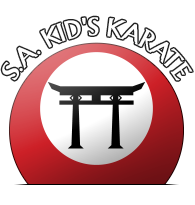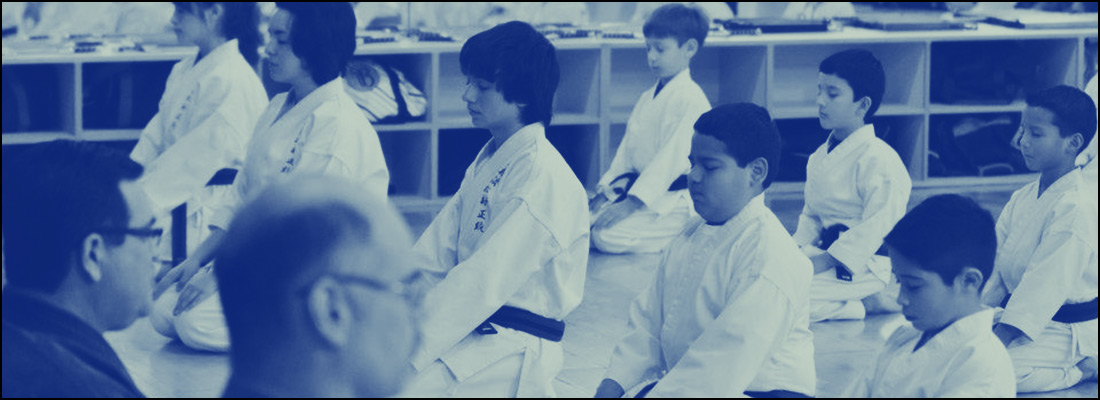SA Kid's Karate Parents say: "It helps my son in school, because the ability to sit, and focus, and learn the lesson was a challenge. Karate helps him with that."
Glossary
- Count to 10
- 1. Ichi
2. Ni
3. San
4. Shi
5. Go
6. Roku
7. Sichi
8. Hachi
9. Ku
10. Ju
- Punches
- Jodan Zuki
Punch to Head
Chudan Zuki
Punch to Mid Section
Gedan Zuki
Punch to Lower Section
Yaka Zuki
Reverse Punch
- Blocks
- Jodan Uke
High Block
Chudan Uke
Middle Block
Gedan Uke
Low Block
Shuto Uke
Knife-hand Block
- Kicks
- Mae Geri
Front Kick
Yoko Geri
Side Snap Kick
Mawashi Geri
Roundhouse Kick
Ushiro Geri
Back Kick
Mikazuki Geri
Crescent Kick
- Stances
- Hachiji Dachi
A Natural Stance, feet about shoulder width apart, with feet pointed slightly outward
Heiko Dachi
A Natural Stance, feet about shoulder width apart, with feet pointed straight forward
Note: Some Kata begin from this position.
Musubi Dachi
An Attention Stance, with feet pointed slightly outward
Kiba Dachi
Horse Stance
Zenkutsu Dachi
Forward Stance
- Basic Karate Terms
- Bo
Staff
Note: It is a long stick used as a weapon, it is approximately 6 feet long.
Dachi
Stance
Do
Way / Path
Note: In Karate, the connotation refers to a way of attaining enlightenment or a way of improving one's character through traditional training.
Dojo
Place of the Way or enlightenment
Note: This is the place where we practice Karate. Traditional etiquette prescribes bowing in the direction of the designated front of the dojo whenever entering or leaving the dojo.
Domo Arigato Gozaimashita
Thank you very much
Note: At the end of each class, it is proper to bow and thank the instructor and those with whom you've trained.
Geri
Kick
Gi
Training uniform
Hai
Yes
Hajime
Begin
Note: "Begin" is a command given to start a given drill, Kata, or Kumite.
Hombu Dojo
A term used to refer to the central dojo of an organization
Ippon Kumite
One step sparring
Jo
Wooden staff, about 4'-5' in length
Note: The "staff" originated as a walking stick.
Karate
Empty hand
Karate Do
The Way of Karate
Note: This implies not only to the physical aspect of Karate, but also the mental and social aspects.
Karateka
Practitioner of Karate
Kata
A form or prescribed pattern of movement
Ki
Mind. Spirit. Energy. Vital-force. Intention.
Kiai
A shout delivered for the purpose of focusing all of one's energy into a single movement
Kihon
Fundamental
Kime
Focus of power
Mokuso
Meditation
Note: Practice often begins or ends with a brief period of meditation, clearing of one's mind.
Nunchaku
An Okinawan weapon consisting of two sticks connected by a rope or chain
Obi
Belt
Rei
Respect
Note: A method of showing respect in Japanese culture is the bow.
Seiza
Proper sitting position
Sempai
Senior student
Sensei
Teacher
Note: It is usually considered proper to address the instructor during practice as "Sensei".
Shomen
Front or top of head, also the designated front of a Dojo
Tai Sabaki
Body movement / shifting
Uke
Block
Waza
Technique
Yame
Stop
Yoi
Ready
Zuki
Punch
Give Us a Call
See how we can help your child gain focus, self-discipline, physical fitness, and other attributes that will assist him or her withstand and overcome life's challenges.
Babcock: 210-377-2600 | Bandera: 210-256-2600







